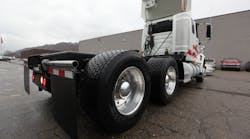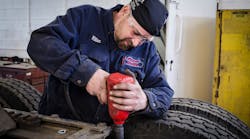Like all truck tires, wide base tires are designed to offer certain performance benefits. But not all fleets want the benefits that wide base tires offer.
Introduced in 2000, a wide base tire takes the place of the standard dual tire configuration on a tractor or trailer. Compared to dual tires, wide base tires are larger in size and have a much wider contact patch.
Typically, one wide base tire can carry as much weight as two dual tires, but will have a lower tire and rim weight, which allows for increased payload and improved fuel economy.
Wide base tires are easier to maintain than dual tires because there is no inside dual tire pressure to match or maintain, and mismatched dual tires and height is eliminated. With fewer tires to check air pressure and tire condition, vehicle inspection time is lessened.
Moreover, the use of wide base tires reduces tire and rim inventory.
Guidance
When does it make sense to spec wide base tires? What can you do to help ensure that they perform in an optimal manner?
Here is some guidance from Evan Perrow, senior product marketing manager, Goodyear Tire & Rubber Company. One of the world’s largest tire companies, Goodyear offers The Total Solution of trusted products, a nationwide network, reliable services and fleet management tools to help commercial trucking fleets lower their total cost of ownership (www.goodyeartrucktires.com).
“For the most part, wide base tires are niche products,” he says. “However, running wide base tires can be very beneficial for fleets that are weight-sensitive and are looking for ways to increase their payloads, such as tanker operations. Wide base tires mounted on aluminum rims oftentimes can significantly reduce a vehicle’s weight.”
Not a Fit
Where does running wide base tires not make sense?
“In the past, fuel savings proved to be a significant benefit of running wide base tires,” Goodyear’s Perrow notes. “That dynamic is less prevalent due to the rise of super fuel-efficient duals that offer even better fuel economy.
“This makes it tougher to quantify wide base tires’ return on investment when it comes to reduced fuel consumption.
“Also in the past, the traditional wide base tire’s perceived lack of ‘limp home capability’ was more of a barrier to the products’ acceptance, especially by long haul fleets,” he continues. “Goodyear’s exclusive, self-sealing DuraSeal Technology, which instantly seals nail-hole punctures of up to ¼” in the repairable area of a tire’s tread, has helped overcome this problem.”
To better understand the pros and cons of wide base tires, and whether or not they would make sense for your operation, consult with your local tire dealer and/or tire service provider and seek their assistance.
Maintenance
For wide base tires, as with all truck tires, “the importance of proper maintenance cannot be [overstated],” stresses Perrow of Goodyear. “Long haul fleets that run wide base tires should pay particular attention to two maintenance practices: inflation checks and truck alignment.
“Maintaining proper inflation pressure is, quite simply, the single most effective thing that a fleet can do to help ensure optimal wide base tire performance while minimizing wear. Fleets should check inflation levels as often as possible.”
Like low inflation, truck misalignment is a condition that warrants special attention, he adds. Over time, a regular alignment program can help combat the occurrence of irregular wear.
“Keep in mind that a traditional front-end alignment isn’t always enough for long haul trucks,” he notes. “Drive axles should be aligned, too.”
A qualified tire service provider can help fleets devise a customized wise base tire maintenance program.
Ready for Retreading?
Like conventional truck tires, wide base tires can be retreaded, and the retread process is the same.
Goodyear’s Perrow says “most fleets place specifications on the number of wide base tire repairs that they allow. Typically, we see fleets retreading wide base tires once or twice in most applications to optimize the casing asset.
“In addition, it’s important for retread performance to compliment new tire performance, so having the highest-quality retread is important.”
Any fleet that contemplates using wide base tires should calculate the ability of these products to drive down its operating costs, he recommends. “It pays to factor the value of retreading into this equation.”






